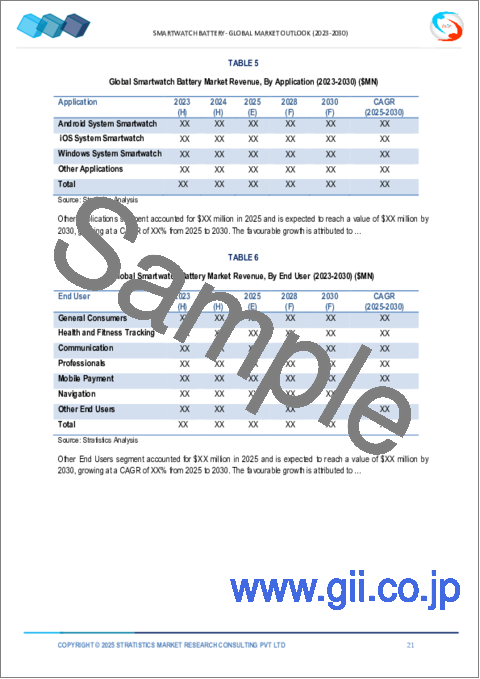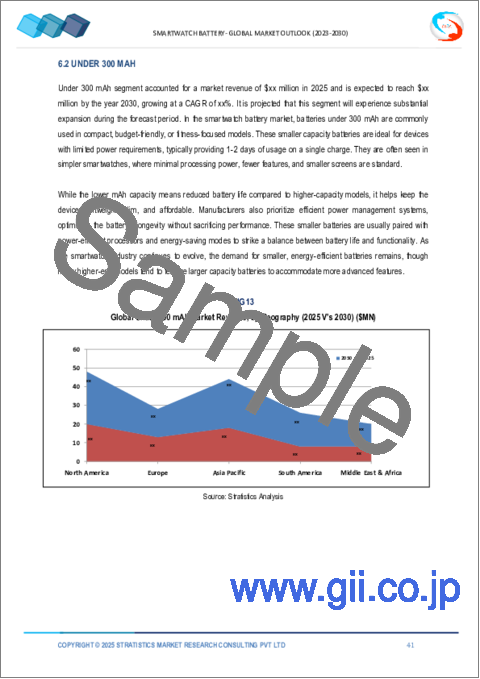|
|
市場調査レポート
商品コード
1569864
スマートウォッチ用バッテリー市場の2030年までの予測: タイプ別、容量別、流通チャネル別、価格帯別、用途別、エンドユーザー別、地域別の世界分析Smartwatch Battery Market Forecasts to 2030 - Global Analysis By Type (Nickel-Metal Hydride (NiMH), Lithium-Ion (Li-Ion), Lithium Polymer (Li-Po) and Other Types), Capacity, Distribution Channel, Price Range, Application, End User and By Geography |
||||||
カスタマイズ可能
|
|||||||
| スマートウォッチ用バッテリー市場の2030年までの予測: タイプ別、容量別、流通チャネル別、価格帯別、用途別、エンドユーザー別、地域別の世界分析 |
|
出版日: 2024年10月10日
発行: Stratistics Market Research Consulting
ページ情報: 英文 200+ Pages
納期: 2~3営業日
|
全表示
- 概要
- 図表
- 目次
Stratistics MRCによると、スマートウォッチ用バッテリーの世界市場は2024年に8億2,000万米ドルを占め、2030年には32億6,000万米ドルに達すると予測され、予測期間中のCAGRは25.8%で成長する見込みです。
スマートウォッチ用バッテリー市場には、スマートウォッチやウェアラブル技術向けに特別に設計された電池の生産、流通、消費が含まれます。この市場には、リチウムポリマーやリチウムイオンなど、モバイル決済、通知、健康追跡機能に電力を供給するさまざまなタイプのバッテリーが含まれます。スマートウォッチの多機能性とスマートフォンとの接続により人気が高まるにつれ、効果的で長持ちする軽量バッテリーのニーズが高まっています。
ウェアラブルへの需要の高まり
スマートウォッチ用バッテリーの市場は、ウェアラブル、特にスマートウォッチの需要の高まりによって大きく牽引されています。消費者がフィットネス・トラッキング、健康モニタリング、通知によるコミュニケーションにスマートウォッチを使用する機会が増えているため、より長寿命のバッテリーが求められています。スマートウォッチがGPS、心拍数トラッキング、睡眠分析、モバイルアプリの統合など高機能化するにつれて、バッテリー寿命の重要性が増しています。ウェアラブルの普及は、リモートワークやデジタルライフスタイルの増加傾向によっても加速しており、消費者は常に充電しなくても一日中使えるウェアラブルを求めています。
限られたバッテリー寿命
スマートウォッチ用バッテリー市場は、GPS、心拍数モニタリング、ヘルス・トラッキングなどの機能要求の高まりによるバッテリー寿命の制限という課題に直面しています。バッテリー技術の進歩にもかかわらず、高いエネルギー消費量とスリムで軽量なデザインとのバランスは依然として課題です。消費者は、スマートウォッチが充電なしで数日間持つことを期待しているが、現在の技術は、特に5G接続や健康センサーのような電力を消費する機能では、こうした期待に応えるのに苦労しています。
バッテリー技術の進歩
バッテリー技術の革新がスマートウォッチ用バッテリー市場の成長を牽引しています。急速に変化する技術、ソリッドステートバッテリー、エネルギー密度の向上により、ユーザーエクスペリエンスとバッテリーの寿命が向上しています。これらの進歩により、スマートウォッチは、継続的な健康モニタリング、5G接続、GPSなどの有用性を損なうことなく、ハイパワー機能を維持することができます。ファッショナブルなデザインを求める消費者の需要に応えるため、メーカーはより小型で柔軟性の高いバッテリーを開発し、より長いバッテリー寿命で機能豊富な商品を提供できるようにしています。
高い開発コスト
環境問題は、特にリチウムイオン電池の使用に関連して、ますます問題になってきています。リチウム、コバルト、ニッケルなどの原材料の採掘によって、生息地の破壊、水質汚染、炭素排出など、環境に重大な影響がもたらされます。廃棄されたバッテリーから有害化学物質が環境中に溶出し、長期的な生態系リスクをもたらすこともあります。環境への害を減らすため、メーカーは規制上の制限や持続可能性に対する消費者の意識の高まりに押され、環境に優しい代替電池の研究やリサイクルシステムの強化に取り組んでいます。
COVID-19の影響
COVID-19の流行は、スマートウォッチ用バッテリー市場に様々な影響を与えました。電池の一時的な不足は、製造の遅れやサプライチェーンの混乱によって引き起こされました。その一方で、この流行は心拍数モニターや睡眠分析装置のようなウェアラブル健康モニターの需要にも拍車をかけた。ウェアラブルの利用は、フィットネス・トラッキングやリモートワークによっても促進されました。しかし、サプライチェーンの制限により、この分野が需要の高まりを満たすことは難しくなった。
ニッケル水素(NiMH)セグメントが予測期間中最大になる見込み
ニッケル水素(NiMH)電池は、リチウムイオン電池の持続可能な代替品として、スマートウォッチ市場でますます普及しています。ニッケル水素電池はサイクル寿命が長く、オーバーヒートしにくいため、ウェアラブル機器に適しています。消費者が安全性と持続可能性をより重視するようになり、ニッケル水素電池の市場は成長すると予測されます。
予測期間中にCAGRが最も高くなると予測されるのは、ヘルス&フィットネストラッキング分野です。
健康・フィットネストラッキング分野は、消費者が自分自身の身体の健康を重視することから、予測期間中に最も高いCAGRを記録すると予測されます。GPSナビゲーション、睡眠トラッキング、心拍モニタリングなどの高度な機能を実現するには、効率的な電力管理が必要です。生産者は、性能を維持しながら寿命を延ばすためにバッテリー技術を進歩させており、その結果、低電力アルゴリズムとエネルギー密度の高いバッテリーが生み出されています。フィットネス動向の高まりとともに、強力なトラッキング機能とバッテリー寿命延長のニーズが高まっています。
最大のシェアを占める地域:
予測期間中、消費者が個人の健康を優先することから、アジア太平洋地域が最大の市場シェアを占めると予想されます。GPSナビゲーション、睡眠トラッキング、心拍数モニタリングなどのスマート機能は、効果的な電力管理を必要とします。生産者は、性能を維持しながら寿命を延ばすためにバッテリー技術を進歩させており、その結果、低電力アルゴリズムとエネルギー密度の高いバッテリーが生み出されています。フィットネスの動向が高まるにつれて、堅牢なトラッキング機能とより長いバッテリー寿命に対する需要が高まっています。
CAGRが最も高い地域:
予測期間中、北米地域が最も高いCAGRを示すと予想されるが、これは最先端のウェアラブル技術に対する消費者の強い嗜好によるものです。この地域は、コネクティビティ、フィットネス・トラッキング、ヘルス・モニタリングなどのサービスを重視する技術に精通した国民が多いという幸運に恵まれています。効果的で長持ちするバッテリーのニーズは、スマートウォッチ、特にアップルやサムスンのような有名企業が製造するスマートウォッチの人気が高まっていることが後押ししています。北米市場は世界のスマートウォッチ用バッテリー市場において引き続き大きな力となっており、健康およびウェルネス技術における幅広い動向を反映しています。
無料のカスタマイズサービス:
本レポートをご購読のお客様には、以下の無料カスタマイズオプションのいずれかをご利用いただけます:
- 企業プロファイル
- 追加市場プレーヤーの包括的プロファイリング(3社まで)
- 主要企業のSWOT分析(3社まで)
- 地域セグメンテーション
- 顧客の関心に応じた主要国の市場推計・予測・CAGR(注:フィージビリティチェックによる)
- 競合ベンチマーキング
- 製品ポートフォリオ、地理的プレゼンス、戦略的提携に基づく主要企業のベンチマーキング
目次
第1章 エグゼクティブサマリー
第2章 序文
- 概要
- ステークホルダー
- 調査範囲
- 調査手法
- データマイニング
- データ分析
- データ検証
- 調査アプローチ
- 調査情報源
- 1次調査情報源
- 2次調査情報源
- 前提条件
第3章 市場動向分析
- 促進要因
- 抑制要因
- 機会
- 脅威
- 用途分析
- エンドユーザー分析
- 新興市場
- COVID-19の影響
第4章 ポーターのファイブフォース分析
- 供給企業の交渉力
- 買い手の交渉力
- 代替品の脅威
- 新規参入業者の脅威
- 競争企業間の敵対関係
第5章 世界のスマートウォッチ用バッテリー市場:バッテリータイプ別
- ニッケル水素(NiMH)
- リチウムイオン(Li-Ion)
- リチウムポリマー(Li-Po)
- その他のタイプ
第6章 世界のスマートウォッチ用バッテリー市場:容量別
- 300mAh未満
- 300mAh~500mAh
- 500mAh以上
第7章 世界のスマートウォッチ用バッテリー市場:流通チャネル別
- オンライン小売
- オフライン小売
- 直接販売
第8章 世界のスマートウォッチ用バッテリー市場:価格帯別
- 予算
- ミッドレンジ
- プレミアム
第9章 世界のスマートウォッチ用バッテリー市場:用途別
- Androidシステムスマートウォッチ
- iOSシステムスマートウォッチ
- Windowsシステムスマートウォッチ
- その他の用途
第10章 世界のスマートウォッチ用バッテリー市場:エンドユーザー別
- 一般消費者
- 健康とフィットネスの追跡
- コミュニケーション
- プロフェッショナル
- モバイル決済
- ナビゲーション
- その他のエンドユーザー
第11章 世界のスマートウォッチ用バッテリー市場:地域別
- 北米
- 米国
- カナダ
- メキシコ
- 欧州
- ドイツ
- 英国
- イタリア
- フランス
- スペイン
- その他欧州
- アジア太平洋
- 日本
- 中国
- インド
- オーストラリア
- ニュージーランド
- 韓国
- その他アジア太平洋地域
- 南米
- アルゼンチン
- ブラジル
- チリ
- その他南米
- 中東・アフリカ
- サウジアラビア
- アラブ首長国連邦
- カタール
- 南アフリカ
- その他中東とアフリカ
第12章 主な発展
- 契約、パートナーシップ、コラボレーション、合弁事業
- 買収と合併
- 新製品発売
- 事業拡大
- その他の主要戦略
第13章 企業プロファイリング
- Samsung SDI
- LG Chem
- Panasonic
- Sony Energy Devices
- Amperex Technology Limited(ATL)
- Apple
- BYD Company Limited
- Garmin
- Fitbit
- Fossil Group
- Huawei
- Amazfit
- Suunto
- TicWatch(Mobvoi)
- Maxell
- Enovix Corporation
List of Tables
- Table 1 Global Smartwatch Battery Market Outlook, By Region (2022-2030) ($MN)
- Table 2 Global Smartwatch Battery Market Outlook, By Battery Type (2022-2030) ($MN)
- Table 3 Global Smartwatch Battery Market Outlook, By Nickel-Metal Hydride (NiMH) (2022-2030) ($MN)
- Table 4 Global Smartwatch Battery Market Outlook, By Lithium-Ion (Li-Ion) (2022-2030) ($MN)
- Table 5 Global Smartwatch Battery Market Outlook, By Lithium Polymer (Li-Po) (2022-2030) ($MN)
- Table 6 Global Smartwatch Battery Market Outlook, By Other Types (2022-2030) ($MN)
- Table 7 Global Smartwatch Battery Market Outlook, By Capacity (2022-2030) ($MN)
- Table 8 Global Smartwatch Battery Market Outlook, By Under 300 mAh (2022-2030) ($MN)
- Table 9 Global Smartwatch Battery Market Outlook, By 300 mAh to 500 mAh (2022-2030) ($MN)
- Table 10 Global Smartwatch Battery Market Outlook, By Over 500 mAh (2022-2030) ($MN)
- Table 11 Global Smartwatch Battery Market Outlook, By Distribution Channel (2022-2030) ($MN)
- Table 12 Global Smartwatch Battery Market Outlook, By Online Retail (2022-2030) ($MN)
- Table 13 Global Smartwatch Battery Market Outlook, By Offline Retail (2022-2030) ($MN)
- Table 14 Global Smartwatch Battery Market Outlook, By Direct Sales (2022-2030) ($MN)
- Table 15 Global Smartwatch Battery Market Outlook, By Price Range (2022-2030) ($MN)
- Table 16 Global Smartwatch Battery Market Outlook, By Budget (2022-2030) ($MN)
- Table 17 Global Smartwatch Battery Market Outlook, By Mid-range (2022-2030) ($MN)
- Table 18 Global Smartwatch Battery Market Outlook, By Premium (2022-2030) ($MN)
- Table 19 Global Smartwatch Battery Market Outlook, By Application (2022-2030) ($MN)
- Table 20 Global Smartwatch Battery Market Outlook, By Android System Smartwatch (2022-2030) ($MN)
- Table 21 Global Smartwatch Battery Market Outlook, By iOS System Smartwatch (2022-2030) ($MN)
- Table 22 Global Smartwatch Battery Market Outlook, By Windows System Smartwatch (2022-2030) ($MN)
- Table 23 Global Smartwatch Battery Market Outlook, By Other Applications (2022-2030) ($MN)
- Table 24 Global Smartwatch Battery Market Outlook, By End User (2022-2030) ($MN)
- Table 25 Global Smartwatch Battery Market Outlook, By General Consumers (2022-2030) ($MN)
- Table 26 Global Smartwatch Battery Market Outlook, By Health and Fitness Tracking (2022-2030) ($MN)
- Table 27 Global Smartwatch Battery Market Outlook, By Communication (2022-2030) ($MN)
- Table 28 Global Smartwatch Battery Market Outlook, By Professionals (2022-2030) ($MN)
- Table 29 Global Smartwatch Battery Market Outlook, By Mobile Payment (2022-2030) ($MN)
- Table 30 Global Smartwatch Battery Market Outlook, By Navigation (2022-2030) ($MN)
- Table 31 Global Smartwatch Battery Market Outlook, By Other End Users (2022-2030) ($MN)
Note: Tables for North America, Europe, APAC, South America, and Middle East & Africa Regions are also represented in the same manner as above.
According to Stratistics MRC, the Global Smartwatch Battery Market is accounted for $0.82 billion in 2024 and is expected to reach $3.26 billion by 2030 growing at a CAGR of 25.8% during the forecast period. The smartwatch battery market encompasses the production, distribution, and consumption of batteries specifically designed for smartwatches and wearable technology. This market covers a range of battery types, including lithium polymer and lithium-ion, that power mobile payments, notifications, and health tracking functions. The need for effective, long-lasting, and lightweight batteries is growing as smartwatches gain popularity due to their multifunctionality and smartphone connection.
Market Dynamics:
Driver:
Growing demand for wearables
The market for smartwatch batteries is significantly driven by the rising demand for wearables, especially smartwatches. Longer-lasting batteries are required since consumers are using smartwatches more and more for fitness tracking, health monitoring, and communication through notifications. Battery life becomes increasingly important as smartwatches get more sophisticated functions like GPS, heart rate tracking, sleep analysis, and mobile app integration. Wearable adoption is also being accelerated by the growing trend of remote work and digital lifestyles, as consumers look for wearables that can last all day without constant charging.
Restraint:
Limited battery life
The smartwatch battery market faces a challenge due to limited battery life due to increasing functionality demands like GPS, heart rate monitoring, and health tracking. Despite advancements in battery technology, balancing high energy consumption with a slim, lightweight design remains a challenge. Consumers expect smartwatches to last several days without charging, but current technology struggles to meet these expectations, especially with power-hungry features like 5G connectivity and health sensors.
Opportunity:
Advancements in battery technology
Innovations in battery technology are driving growth in the smartwatch battery market. The user experience and battery longevity are enhanced via fast-changing technologies, solid-state batteries, and increased energy density. These advancements allow smartwatches to maintain high-power features without compromising usefulness, such as continuous health monitoring, 5G connection, and GPS. In response to consumer demand for fashionable designs, manufacturers are developing smaller and more flexible batteries, allowing them to offer feature-rich goods with longer battery lives.
Threat:
High development costs
Environmental issues are becoming more and more of a problem, particularly in relation to lithium-ion battery use. Significant environmental effects, including as habitat damage, water pollution, and carbon emissions, are caused by the exploitation of raw materials like lithium, cobalt, and nickel. Toxic chemicals from discarded batteries can leach into the environment, posing long-term ecological risks. In order to reduce environmental harm, manufacturers are being pushed by regulatory restrictions and growing consumer awareness of sustainability to investigate eco-friendly battery alternatives and enhance recycling systems.
Covid-19 Impact
The COVID-19 epidemic has affected the market for smartwatch batteries in a variety of ways. Temporary shortages of batteries were caused by manufacturing slowdowns and supply chain disruptions. On the other hand, the epidemic also spurred demand for wearable health monitors, like heart rate monitors and sleep analyzers. Wearable usage was also spurred by fitness tracking and remote work. Supply chain limitations, however, made it more difficult for the sector to satisfy the rising demand.
The nickel-metal hydride (NiMH) segment is expected to be the largest during the forecast period
The nickel-metal hydride (NiMH) segment is projected to account for the largest market share during the projection period, due to their moderate energy density and eco-friendliness; nickel-metal hydride (NiMH) batteries are becoming more and more popular in the smartwatch market as a sustainable substitute for lithium-ion batteries. They are appropriate for wearable devices because they have a longer cycle life and are less likely to overheat. The market for NiMH batteries is predicted to grow as consumers place a greater priority on safety and sustainability.
The health and fitness tracking segment is expected to have the highest CAGR during the forecast period
The health and fitness tracking segment is anticipated to witness the highest CAGR during the forecast period, as consumers place a premium on their own physical well-being. Efficient power management is necessary for advanced capabilities like GPS navigation, sleep tracking, and heart rate monitoring. Producers are advancing battery technology to increase longevity while maintaining performance, which has resulted in the creation of low-power algorithms and energy-dense batteries. The need for strong tracking features and extended battery life is growing as fitness trends increase.
Region with largest share:
During the projected timeframe, the Asia pacific region is expected to hold the largest market share, as consumers prioritize personal wellness. Smart features like as GPS navigation, sleep tracking, and heart rate monitoring require effective power management. Producers are advancing battery technology to increase longevity while maintaining performance, which has resulted in the creation of low-power algorithms and energy-dense batteries. As fitness trends grow, the demand for robust tracking capabilities and longer battery life intensifies.
Region with highest CAGR:
Over the forecasted timeframe, the North America region is anticipated to exhibit the highest CAGR, owing to consumers' strong preference for cutting-edge wearable technologies. This area is fortunate to have a tech-savvy populace that values services like connectivity, fitness tracking, and health monitoring. The need for effective and long-lasting batteries is fuelled by the growing popularity of smartwatches, especially those made by well-known companies like Apple and Samsung. The North American market continues to be a major force in the global smartwatch battery market, reflecting broader trends in health and wellness technology, as manufacturers develop to fulfill these demands.
Key players in the market
Some of the key players profiled in the Smartwatch Battery Market include Samsung SDI, LG Chem, Panasonic, Sony Energy Devices, Amperex Technology Limited (ATL), Apple, BYD Company Limited, Garmin, Fitbit, Fossil Group, Huawei, Amazfit, Suunto, TicWatch (Mobvoi), Maxell and Enovix Corporation.
Key Developments:
In May 2022, Enovix Corporation, one of the front-runners in designing and manufacturing next-generation 3D silicon lithium-ion batteries, declared that it had cleared a significant technology validation breakthrough. Also, it has consequently received the first order for its high-energy density smartwatch battery from one of the major consumer electronics companies of the world. This order marks the beginning of the next phase of the customer's product development process.
In April 2021, Samsung Electronics planned to use batteries from China's Amperex Technology Limited (ATL) and Samsung SDI for its new smartwatch, Galaxy Watch 4.
Battery Types Covered:
- Nickel-Metal Hydride (NiMH)
- Lithium-Ion (Li-Ion)
- Lithium Polymer (Li-Po)
- Other Types
Capacities Covered:
- Under 300 mAh
- 300 mAh to 500 mAh
- Over 500 mAh
Distribution Channels Covered:
- Online Retail
- Offline Retail
- Direct Sales
Price Ranges Covered:
- Budget
- Mid-range
- Premium
Applications Covered:
- Android System Smartwatch
- iOS System Smartwatch
- Windows System Smartwatch
- Other Applications
End Users Covered:
- General Consumers
- Health and Fitness Tracking
- Communication
- Professionals
- Mobile Payment
- Navigation
- Other End Users
Regions Covered:
- North America
- US
- Canada
- Mexico
- Europe
- Germany
- UK
- Italy
- France
- Spain
- Rest of Europe
- Asia Pacific
- Japan
- China
- India
- Australia
- New Zealand
- South Korea
- Rest of Asia Pacific
- South America
- Argentina
- Brazil
- Chile
- Rest of South America
- Middle East & Africa
- Saudi Arabia
- UAE
- Qatar
- South Africa
- Rest of Middle East & Africa
What our report offers:
- Market share assessments for the regional and country-level segments
- Strategic recommendations for the new entrants
- Covers Market data for the years 2022, 2023, 2024, 2026, and 2030
- Market Trends (Drivers, Constraints, Opportunities, Threats, Challenges, Investment Opportunities, and recommendations)
- Strategic recommendations in key business segments based on the market estimations
- Competitive landscaping mapping the key common trends
- Company profiling with detailed strategies, financials, and recent developments
- Supply chain trends mapping the latest technological advancements
Free Customization Offerings:
All the customers of this report will be entitled to receive one of the following free customization options:
- Company Profiling
- Comprehensive profiling of additional market players (up to 3)
- SWOT Analysis of key players (up to 3)
- Regional Segmentation
- Market estimations, Forecasts and CAGR of any prominent country as per the client's interest (Note: Depends on feasibility check)
- Competitive Benchmarking
- Benchmarking of key players based on product portfolio, geographical presence, and strategic alliances
Table of Contents
1 Executive Summary
2 Preface
- 2.1 Abstract
- 2.2 Stake Holders
- 2.3 Research Scope
- 2.4 Research Methodology
- 2.4.1 Data Mining
- 2.4.2 Data Analysis
- 2.4.3 Data Validation
- 2.4.4 Research Approach
- 2.5 Research Sources
- 2.5.1 Primary Research Sources
- 2.5.2 Secondary Research Sources
- 2.5.3 Assumptions
3 Market Trend Analysis
- 3.1 Introduction
- 3.2 Drivers
- 3.3 Restraints
- 3.4 Opportunities
- 3.5 Threats
- 3.6 Application Analysis
- 3.7 End User Analysis
- 3.8 Emerging Markets
- 3.9 Impact of Covid-19
4 Porters Five Force Analysis
- 4.1 Bargaining power of suppliers
- 4.2 Bargaining power of buyers
- 4.3 Threat of substitutes
- 4.4 Threat of new entrants
- 4.5 Competitive rivalry
5 Global Smartwatch Battery Market, By Battery Type
- 5.1 Introduction
- 5.2 Nickel-Metal Hydride (NiMH)
- 5.3 Lithium-Ion (Li-Ion)
- 5.4 Lithium Polymer (Li-Po)
- 5.5 Other Types
6 Global Smartwatch Battery Market, By Capacity
- 6.1 Introduction
- 6.2 Under 300 mAh
- 6.3 300 mAh to 500 mAh
- 6.4 Over 500 mAh
7 Global Smartwatch Battery Market, By Distribution Channel
- 7.1 Introduction
- 7.2 Online Retail
- 7.3 Offline Retail
- 7.4 Direct Sales
8 Global Smartwatch Battery Market, By Price Range
- 8.1 Introduction
- 8.2 Budget
- 8.3 Mid-range
- 8.4 Premium
9 Global Smartwatch Battery Market, By Application
- 9.1 Introduction
- 9.2 Android System Smartwatch
- 9.3 iOS System Smartwatch
- 9.4 Windows System Smartwatch
- 9.5 Other Applications
10 Global Smartwatch Battery Market, By End User
- 10.1 Introduction
- 10.2 General Consumers
- 10.3 Health and Fitness Tracking
- 10.4 Communication
- 10.5 Professionals
- 10.6 Mobile Payment
- 10.7 Navigation
- 10.8 Other End Users
11 Global Smartwatch Battery Market, By Geography
- 11.1 Introduction
- 11.2 North America
- 11.2.1 US
- 11.2.2 Canada
- 11.2.3 Mexico
- 11.3 Europe
- 11.3.1 Germany
- 11.3.2 UK
- 11.3.3 Italy
- 11.3.4 France
- 11.3.5 Spain
- 11.3.6 Rest of Europe
- 11.4 Asia Pacific
- 11.4.1 Japan
- 11.4.2 China
- 11.4.3 India
- 11.4.4 Australia
- 11.4.5 New Zealand
- 11.4.6 South Korea
- 11.4.7 Rest of Asia Pacific
- 11.5 South America
- 11.5.1 Argentina
- 11.5.2 Brazil
- 11.5.3 Chile
- 11.5.4 Rest of South America
- 11.6 Middle East & Africa
- 11.6.1 Saudi Arabia
- 11.6.2 UAE
- 11.6.3 Qatar
- 11.6.4 South Africa
- 11.6.5 Rest of Middle East & Africa
12 Key Developments
- 12.1 Agreements, Partnerships, Collaborations and Joint Ventures
- 12.2 Acquisitions & Mergers
- 12.3 New Product Launch
- 12.4 Expansions
- 12.5 Other Key Strategies
13 Company Profiling
- 13.1 Samsung SDI
- 13.2 LG Chem
- 13.3 Panasonic
- 13.4 Sony Energy Devices
- 13.5 Amperex Technology Limited (ATL)
- 13.6 Apple
- 13.7 BYD Company Limited
- 13.8 Garmin
- 13.9 Fitbit
- 13.10 Fossil Group
- 13.11 Huawei
- 13.12 Amazfit
- 13.13 Suunto
- 13.14 TicWatch (Mobvoi)
- 13.15 Maxell
- 13.16 Enovix Corporation






